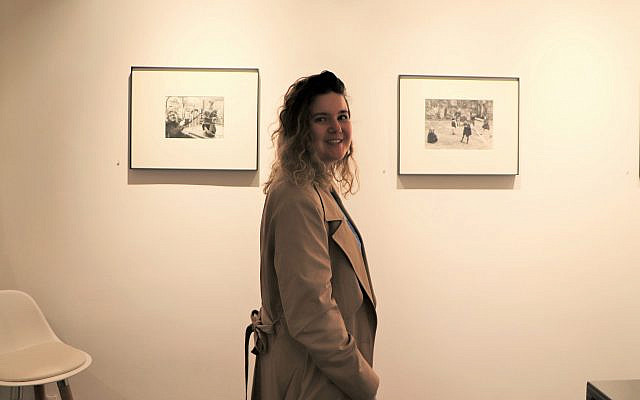More Than Machinery, We Need Humanity, Paris






La Galerie Rouge’s current exhibition, “The Concerned Photographer / La Photographie Humaniste,” offers a deep exploration into the realms of humanistic photography and concerned photography, fusing the visual narratives of two significant movements of the 20th century.
Whereas humanistic photography is often associated with Europe, particularly France, and aims to capture the nobility in the common man and the beauty of everyday life and spontaneous moments—a philosophical stance that emerged after World War I—concerned photography traces its roots to the United States. It can be considered an evolution of social documentary photography, which dates back to the 19th century with pioneers such as Henry Mayhew, Jacob Riis, and Lewis Hine, and later the Depression-era photographers such as Walker Evans, Dorothea Lange, and Gordon Parks, who aimed to draw public attention to ongoing social issues by portraying the lives of underprivileged and disadvantaged individuals.
Therefore, both social documentary and concerned photography aim to document social issues. However, concerned photography went one step further by actively advocating for social change and justice to prevent further tragedies. Thus, the term concerned photographer, coined by American photojournalist Cornell Capa (1918-2008), was dedicated to photographers who demonstrated a humanitarian impulse to use their images to both, record the world after World War II and to educate and inspire change.
In 1967, Cornell Capa curated an exhibition titled ‘The Concerned Photographer” in New York, honoring photographers like his brother, Robert Capa, and his friend David Seymour, who died while documenting conflicts. This exhibition laid the groundwork for the International Center for Photography in New York in 1974, which became a beacon for socially engaged photography.
Cornell Capa’s remarks on the Pulitzer Prize-winning photograph “The Napalm Girl / The Terror of War” by Nick Ut, depicting a severely burned 9-year-old girl fleeing naked during the Vietnam War, underscore the power of visual imagery to influence public opinion and policy. He believed such images could bring about change, even ending wars by exposing the human cost and atrocities.
“With all the arguments and discussions about the Vietnam War, what did the visual image do? It ended the war.” Cornell Capa
Now when stepping into La Galerie Rouge, visitors encounter a captivating juxtaposition of images that reflect the challenges and complexities of the era of these photographers, which resonate with the complexities and challenges of our contemporary world. Within this exhibition, viewers are presented with two opposing yet coexisting realities. On the one hand, there is the lightness and small pleasures captured by photographers like Robert Doisneau, whose ‘Les Animaux Superieurs, 1954,’ portrays a monkey in a striped shirt, showcasing humanity’s fascination with animals outside their natural habitat. Similarly, Edouard Boubat’s ‘Un couple qui S’embrasse, Île Saint-Louis, Paris, 1956,’ displaying a couple passionately embracing each other, evokes moments of intimacy and tranquility amidst bustling city life and a world in a fragile and uncertain state. On the other hand, Sabine Weiss’s photograph ‘Aubervilliers’ (1952) portraying children playing in this multicultural suburb of Paris, offers a charming insight into the innocence and simple joys found in childhood.
Through the lenses of these photographers, viewers are invited to witness the beauty and poignancy of ordinary life and people’s coping mechanisms amidst the Cold War tensions and political changes their lives were embedded in. Despite facing criticism for their focus on poetic realism, these photographers deliver an important message: the significance of human connection and the embracement of the good amid the challenges.
In the words of French photographer and historian Jean Claude Gautrand, humanistic photography is described as “a lyrical trend, warm, fervent, and responsive to the sufferings of humanity, which began to assert itself during the 1950s in Europe, particularly in France … photographers dreamed of a world of mutual succor and compassion, encapsulated ideally in a solicitous vision.”
On the other hand, the exhibit also offers the troubling images of the concerned photographers. These two photography movements may initially seem to stand in stark contrast to one another, but rather than presenting them as conflicting entities, this exhibition beautifully demonstrates how they can complement each other. For one thing, many photographers of diverse nationalities collaborated with the same press and photography agencies, such as the Magnum and Rapho agency, underscoring the interconnectedness of their work. This interconnectedness is exemplified by their inclusion in Edward Steichen’s groundbreaking exhibition, The Family of Man, held at the Museum of Modern Art in New York in 1955. This exhibition, which aimed to be a manifesto for peace and the fundamental equality of humanity through post-war humanistic photography, quickly became one of the most celebrated photography exhibitions in history. Featuring over 503 photographs by 273 photographers from 68 countries, it depicted various aspects of human life, culture, and society, fostering a sense of global solidarity.
The enduring impact of The Family of Man is evident in its extensive world tour, which included stops in 37 countries and over 160 museums. Its final installation in 1994 at the Château de Clervaux in Luxembourg solidified its place in the annals of photographic history. While the exhibition was widely praised, critics such as Roland Barthes, Walter Benjamin, and Susan Sontag pointed out its shortcomings in adequately addressing significant social and political differences between countries or effectively communicating meaningful messages about humanity.
Nevertheless, since 2003, The Family of Man has been recognized for its cultural significance and included in the UNESCO Memory of the World Register, underscoring its enduring legacy and global impact.
https://www.moma.org/calendar/exhibitions/2429
https://www.visit-clervaux.lu/fr/art/the-family-of-man
Thus, among the highlights of the concerned photography images in La Galerie Rouge’s exhibit is David Seymour’s photograph titled “Tremblement de terre, La Tristesse de Zante Greece,” taken in 1953. The image portrays the devastating aftermath of an earthquake on the island of Zakynthos, located in the Ionian Sea. Through Seymour’s lens, we witness the destruction of buildings and the palpable horror etched on a woman’s face, encapsulating the profound impact of natural disasters on communities. The image serves as a reminder of the recent earthquakes in the world and the destruction we’ve seen in our recent wars.
Another poignant photograph by him depicts a group of six young male teenagers seated on stacked stones. This image offers a glimpse into the Albergo dei Poveri, a historic complex in Naples, Italy, originally built as a hospice and shelter for the poor. Constructed in the 18th century to provide aid to the city’s impoverished residents, the Albergo dei Poveri underwent various transformations over time.
During the mid-20th century, particularly during and after World War II, the complex served different purposes, including housing displaced persons and functioning as a center for social services. The photograph captures one of the spaces within the Albergo dei Poveri during this period of transition, possibly used as a correctional facility or temporary housing for boys. Through this image, viewers are confronted with the complexities of social welfare and the stigmatization that it may bring forth, but also the connection between poverty, displacement, segregation, and behavioral issues.
Another compelling photograph featured in the exhibition is Jean-Philippe Charbonnier’s “Torride, Castille, Espagne, 1953.” The image captures three young girls and what appears to be their father standing against the backdrop of a windmill. Their expressions are stern, adding a sense of gravity to the scene. Charbonnier’s composition, shot from a low-angle perspective or “worm-eye view,” amplifies the presence of the subjects, making them appear larger and more imposing against the sky and background.
The title “Torride Castille” likely refers to the Castile region of Spain, known for its traditional agrarian economy during the 1950s, where agriculture was the primary occupation. The region boasts a rich history and cultural heritage, with historic cities and towns dating back centuries. However, Spain was under the dictatorship of General Francisco Franco during this time, characterized by authoritarianism, censorship, and political repression.
The climate of Castile is marked by hot and dry summers, fitting the description of “torrid” (meaning extremely hot and dry). This climate influenced agricultural practices and shaped the way of life in the region, adding layers of complexity to Charbonnier’s photograph. Through this image, viewers are invited to reflect on the intersection of history, culture, and climate, as well as the dynamics of power and authority during Franco’s regime.
Additionally, two compelling images by Dave Heath are featured in the exhibition. One titled ‘Hands of a Negro’ (1960) depicts a close-up of an elderly Black person’s hands, without showing the head or any recognizable features, set against a blurred nighttime background. The hands in the foreground suggest the toil of hard labor, adding depth to the narrative of resilience and struggle during a time when segregation in the US still persisted.
In another photograph, Heath captures a group of mostly stern-looking Mexican boys, also shot in 1960, evoking a time when children were often subjected to child labor and faced challenges accessing quality education, particularly in regions with lower-income families. Despite Mexico’s efforts to expand educational opportunities, access to quality schooling remains limited in certain areas to this day, exacerbating socio-economic disparities. Through Heath’s lens, viewers are confronted with the harsh realities of inequality and the enduring struggle for educational equity among marginalized communities.
In a world marred by the complexities of the ongoing pandemic, the devastating conflicts in Ukraine and Gaza, and the growing threats of environmental damage and terrorism, it is easy to feel overwhelmed by the weight of our collective challenges. As we navigate through these turbulent times, the power of photography as a medium for social commentary and cultural critique becomes ever more important.
The current exhibition at Galerie Rouge serves as a poignant reminder of the transformative impact of photography in fostering dialogue, empathy, and action towards creating a more just and compassionate world. Yet, some of them also offer a moment of relief, inviting us to pause and reflect on the beauty that surrounds us, even in the face of adversity.
As we continue to grapple with the aftermath of the pandemic, it is crucial that we not only acknowledge the profound toll it has taken on our mental health but also honor the millions of lives lost and the countless others who continue to suffer. Let us heed the words of Maria Van Kerkhove, interim director of the WHO’s Department of Epidemic and Pandemic Preparedness and Prevention, as she reminds us in an interview with Scientific American published on February 6, 2024, that we are still in the post-pandemic phase and stresses the importance of collective mourning and remembrance for the 7 million lives that were lost (Note: The actual number may be three times higher).
In the face of such daunting challenges, let us not lose sight of the beauty that still exists in the world. Let us use our cameras to continue capturing fleeting moments of joy and wonder but also to shine a light on the social injustices that demand our attention and action. Just as the photographers showcased in this exhibition have done, let us harness the power of photography to advocate for change, amplify the voices of the marginalized, and inspire compassion and solidarity.
As we contemplate the significance of this exhibition, let us also envision the possibility of a global travel exhibit, akin to Edward Steichen’s seminal ‘The Family of Man,’ that transcends borders and cultures to unite humanity in our shared pursuit of a better world. Let us embrace the transformative potential of photography as a catalyst for social change and collective healing.
While the exhibition at La Galerie Rouge may not match the scale of the ‘Family of Man,’ it nonetheless offers a compelling and thought-provoking collection of images worthy of exploration. Thus, as a concerned art reviewer, I invite you to visit Galerie Rouge either online or in person and experience firsthand the profound impact of these images. May they serve as a source of inspiration, empowerment, or comfort, as we strive to navigate the complexities of our world with courage, compassion, and resilience.
“The concerned photographer finds the present unacceptable and tries to change it. Our goal is simply to let the world know why it is unacceptable.” – Cornell Capa
The Concerned Photographer / La Photographie Humaniste
(March 21 – May 11, 2024)
La Galerie Rouge
3 rue du Pont Louis-Philippe, 75004 Paris



